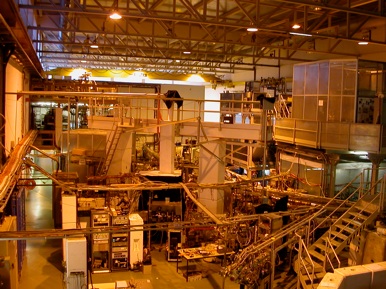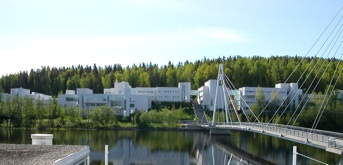Laser spectroscopy of radioactive isotopes
Laser spectroscopy provides a fast and efficient technique for atomic hyperfine structure and isotope shift measurements.
The perturbation and splitting of the electronic energy levels by the nucleus permits the determination of nuclear properties from optical spectra. These include quantum properties such as the nuclear spin and magnetic dipole moment, and collective size and shape effects given by the electric quadrupole moment and mean-square charge radius. High-resolution spectroscopy is employed by the group to study radioactive nuclei at international facilities.

ISOLDE, CERN
Nuclear structure research is driven by the study of isotopes far from stability. By their nature, such radioactive nuclei are short lived and must therefore be studied at the site of production. At international facilities such asISOLDE, CERN, high-energy particle accelerators are used to induce nuclear fission. These products are then extracted in the form of a fast ion beam, mass analysed and delivered to the “on-line” laser spectroscopy station. Here, the laser beam is overlapped collinearly with the fast-ion beam. In this geometry the overlap between ions and laser light is maximised and the velocity spread is compressed to a point where the residual Doppler broadening is comparable to the atomic natural linewidths.

University of Jyväskylä Accelerator Laboratory, Finland
While the production yields at ISOLDE are relatively high for many nuclides, the problems of extracting refractory elements from the thick targets (through heating) calls for a different approach. At the University of Jyväskylä Accelerator Laboratory, Finland, the reaction products are produced using thin foil targets and recoil into a gas cell prior to extraction, in what is known as an IGISOL (Ion Guide Isotope Separator On-Line) technique. While the radioactive yields at “traditional-style” production facilities are generally higher, the IGISOL method becomes advantageous for such refractory elements. Use of the IGISOL also permits the study of species with half-lives shorter than a millisecond due to the faster extraction time. The group has pioneered the application of the IGISOL technique to collinear laser spectroscopy as well as the use of cooled, bunched beams to reduce the photon background experienced when using fluorescence detection methods.
Research Staff
- Dr Paul Campbell
- Professor Kieran Flanagan
- Dr Kara Lynch
